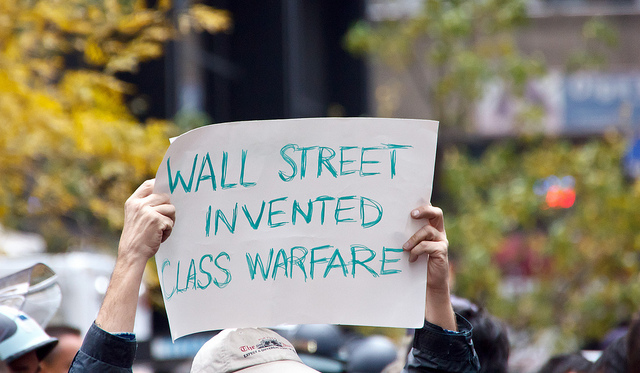“There’s class warfare, all right, but it’s my class, the rich class, that’s making war, and we’re winning.” — Warren Buffett
The United States fiscal cliff — if they fall off it is because they are cutting taxes and spending on the wrong things.
Repeating over and over again the idea that taxing the rich, government social programs and regulation are the cause of unemployment, low wages, debt, stagnation and lack of innovation doesn’t make it true. Corporate taxes were much higher and financial regulation much stricter during the American economic golden age from the late 1940s to the early 1970s; higher rates of economic growth, wages and productivity were the norm while the unemployment rate was lower. As for the current U.S. national debt, it is the result of the Bush tax cuts, the wars in Iraq and Afghanistan, the ‘Great Recession’ triggered by the deregulated financial system and a for-profit, out-of-control health-care system.
As of 2012 U.S. companies had piled up approximately $5 trillion in cash reserves. The U.S. economy is about $15 trillion — so their corporations are sitting on unspent profits equal to one-third of their entire economy alongside supposedly unsustainable debt, high unemployment, the most inequality and one of the least upwardly mobile economies in the industrialized world. Through 2012, 93 per cent of the income growth since the economy began to grow again in 2009 went to the top 1 per cent.
What does the business class think is going on?
According to a Citigroup note to its investors:
“The World is dividing into two blocs — the Plutonomy and the rest. The U.S., UK, and Canada are the key Plutonomies — economies powered by the wealthy. Continental Europe (ex-Italy) and Japan are in the egalitarian bloc. There is no ‘average consumer’ in a Plutonomy. Consensus analyses focusing on the ‘average’ consumer are flawed from the start. The top 1% of households in the U.S., (about 1 million households) accounted for about 20% of overall U.S. income in 2000, slightly smaller than the share of income of the bottom 60% of households put together. That’s about 1 million households compared with 60 million households, both with similar slices of the income pie! Clearly, the analysis of the top 1% of U.S. households is paramount. To continue with the U.S., the top 1% of households also account for 33% of net worth, greater than the bottom 90% of households put together. It gets better (or worse, depending on your political stripe) — the top 1% of households account for 40% of financial net worth, more than the bottom 95% of households put together.” (Citigroup Equity Strategy Industry Note, October 16, 2005).
Minimalist policy options for the U.S.?
Tax the corporations’ idle profits and the trillions hidden in tax havens (please see my last blog), invest it in a green economy, introduce a single-payer health-care system, stop the neocolonial wars and the spending that goes with it and solve the debt problem or let them sit on our wealth in $80 million private submarines or the latest 180-metre (590-foot), $600 million yacht.
Like this article? Chip in to keep stories like these coming!
Photo: Andreas Metz/flickr




